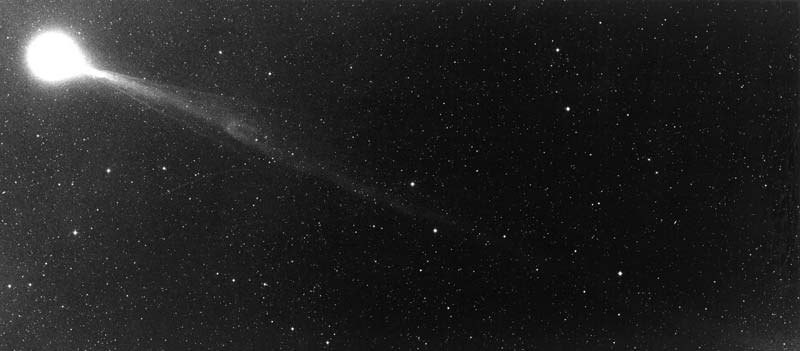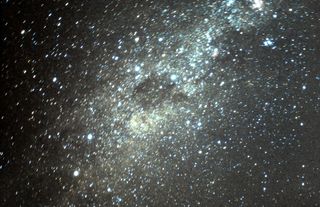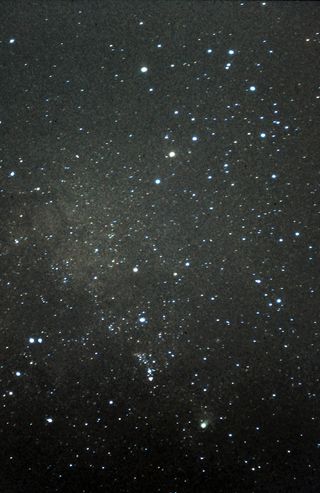
Twenty-five years ago, in April 1986, I had the privilege to serve as a tour guide for a most unusual astronomical tour that began in Santiago, Chile, then shifted 2,334 miles (3,756 km) out over the South Atlantic Ocean to one of the world's most isolated spots on Earth, Easter Island. We then returned to Chile, where we traveled to a specially selected dark-sky site in the Andes Mountains.
I was making this long and rather arduous journey with about two dozen others to get a view of Halley’s Comet. April 1986 was to be the month of its greatest splendor but alas, it would be much too low to be well-seen from mid-northern latitudes. But for those who journeyed to the Southern Hemisphere, Halley was expected to shine in all its glory: as bright as second magnitude (equal in brightness to Polaris, the North Star) with at least a 20- to possibly even 40-degree tail; a sight not to be forgotten — or so we were led to believe. Sadly, comets often tend to be capricious, and what we actually saw of Halley was best described by one of the tour participants as a "smur," which she defined as a cross between a smudge and a blur. Halley never got brighter than third magnitude (as bright as the star Megrez, which joins the handle and bowl of the Big Dipper) and displayed a short, wide, stubby appendage that modestly passed for something of a tail.
But as poorly as Halley performed, we were all amply compensated by the view of the deep-southern stars and constellations. ['Supermoon' Photos From Around The World: March 19, 2011]

I still vividly remember my first night on Easter Island — we had a perfect view of the sky from right outside our hotel (the "Hanga Roa") — and noticed how many of the constellations we were so familiar with back home, appeared upside down, primarily because they were originally created by inhabitants north of the equator who hadn't imagined what they'd look like to stargazers south of the equator.
Upside-down sky
During the evening hours I looked to the north to find the Big Dipper strangely oriented with its bowl pointing downward and just skimming above the horizon. In contrast, from New York, the Dipper would be almost directly overhead. I could not use the "Pointer Stars" (Dubhe and Merak) to locate Polaris, since from Easter Island it had sunk 27 degrees below the northern horizon. And not only were many familiar star patterns inverted, but their associations with the seasons were also turned around. Orion, a stereotypically "winter" constellation in the north, belongs to the Southern Hemisphere summer, while Scorpius is aligned with mid-winter.
But our very best views of the sky came when we flew back to Chile and traveled into the Andes Mountains to a site near the village of La Serena at latitude 30-degrees south and an altitude of around 7,000-feet above sea level. On one beautifully clear April evening, I gaped at a sky that was unquestionably the most magnificent that I had ever been privileged to see. An arch of innumerable stars reached almost horizon to horizon, and was crowned high in the south by the famous Southern Cross (Crux) with the brilliant stars Alpha and Beta Centauri glowing nearby. And all of this was set against the soft glow of the Milky Way, mottled with light and dark areas including the pear-shaped inky spot of darkness popularly known as the Coalsack, nestled against Crux. Although it appears as a gaping hole in the Milky Way, the Coalsack is really a great cloud of dust obscuring the multitude of stars that lie beyond it. [Gallery: Cosmic Visions From Chile's Paranal Observatory]
Get the Space.com Newsletter
Breaking space news, the latest updates on rocket launches, skywatching events and more!
Later in the night we saw the great star clouds in Sagittarius that marked the center of our Milky Way galaxy, appearing so bright that they cast faint, yet distinct shadows! I had brought 7 x 35 binoculars and a 3.1-inch refracting telescope with me and spent much of the time scanning what I later described to our group as a “celestial candy store of treats.” The treasures embedded were virtually limitless. No star chart, atlas or planetarium had prepared me for the true splendor of the southern sky. I could have stayed all night; however, some of the people in our group began to complain of the cold so we had to cut it short.
On the last evening of our tour, we all got together to discuss our experiences and one woman got up and expressed her thoughts about the spectacular scenery and added: "The days were sort of funny; the sun just somehow never seemed to be right." She wasn't aware of the drastic changes such a large latitude difference makes in the sun’s daily path, but she picked up on the fact that it moves to the left during the day, not right, as she had been used to all of her life.
Halley: Past and Future

The reason why Halley’s Comet did so poorly in 1986 was a matter of celestial geometry. When the comet made its closest approach to the sun in early February — and when it was also at its brightest — it was situated on the opposite side of the sun as seen from Earth and it was hidden in the solar glare. It then swept around the sun and into the predawn morning sky. Unfortunately for those living north of the equator, the comet was heading south, making observations of it difficult. But Halley was also approaching Earth and would be at its closest — 39 million miles (63 million km) — on April 9. That’s why many of the comet tours and expeditions were arranged for around that time. But the comet was also two months past its brightest phase and even though it was nearly four times closer than it was in February, it still appeared unimpressive.
Halley is still moving away from the sun and will arrive at the far end of its elliptical orbit in December 2023. It will then start on its way back in toward the sun, making its closest approach on July 28, 2061.
That 2061 return will be much different than 1986. On the same day that Halley is passing closest to the sun, it will also be passing closest to Earth at a distance of 45 million miles (72 million km). And unlike 1986, when the comet moved into the morning sky and headed south, in 2061 Halley will become an evening object and will head north, this time favoring those in the Northern Hemisphere. During the final days of July into the first week of August, Halley will likely shine as brightly as a zero-magnitude star — about 15 times brighter than it was in 1986 — and will be easily visible about 10-degrees above the northwest horizon in the late twilight sky. The tail should also be far more prominent, appearing to stand almost straight up from the comet’s head; a very striking sight.
As good as that apparition will be, at Halley’s following appearance in the spring of 2134, an even grander spectacle will take place. On May 7 of that year, the comet will pass just 8.5 million miles (13.8 million km) from Earth; its closest approach since 837 A.D. The comet will then shine as bright as Jupiter and its tail will likely stretch across the greater part of the sky. Our great, great, great, great grandchildren are going to be in for quite a show!
Anyone 30 years of age or under who is reading these words now has (I think) a pretty good chance of seeing Halley when it returns a half century from now. I myself would love to see Halley for a second time in my life (in fact, a few people on our 1986 adventure had previously seen it on its 1910 return). But I turned 30 at its last visit. Still, I plan to stick to my daily regimen of taking vitamins as well as doing a lot of good wishing, but . . . well, so it goes.
Some Final Thoughts
In closing, anyone from the Northern Hemisphere who travels to far southern lands should certainly plan to make skywatching a major part of

the trip. After all, never before have so many people — especially those of ordinary means — been able to wander the globe as much as now. And when I refer to "southern lands" I’m not referring to the Caribbean and Hawaii. Go as far south of the equator as I did a quarter of a century ago, where those beautiful southern sky objects are high up and unaffected by horizon haze and dimming. In recent years, various astronomical tour groups have traveled to the Southern Hemisphere for eclipses or other purposes, and nighttime sky observing has been a major attraction.
You’ll come home spoiled!
Joe Rao serves as an instructor and guest lecturer at New York's Hayden Planetarium. He writes about astronomy for The New York Times and other publications, and he is also an on-camera meteorologist for News 12 Westchester, New York.
Join our Space Forums to keep talking space on the latest missions, night sky and more! And if you have a news tip, correction or comment, let us know at: community@space.com.

Joe Rao is Space.com's skywatching columnist, as well as a veteran meteorologist and eclipse chaser who also serves as an instructor and guest lecturer at New York's Hayden Planetarium. He writes about astronomy for Natural History magazine, the Farmers' Almanac and other publications. Joe is an 8-time Emmy-nominated meteorologist who served the Putnam Valley region of New York for over 21 years. You can find him on Twitter and YouTube tracking lunar and solar eclipses, meteor showers and more. To find out Joe's latest project, visit him on Twitter.